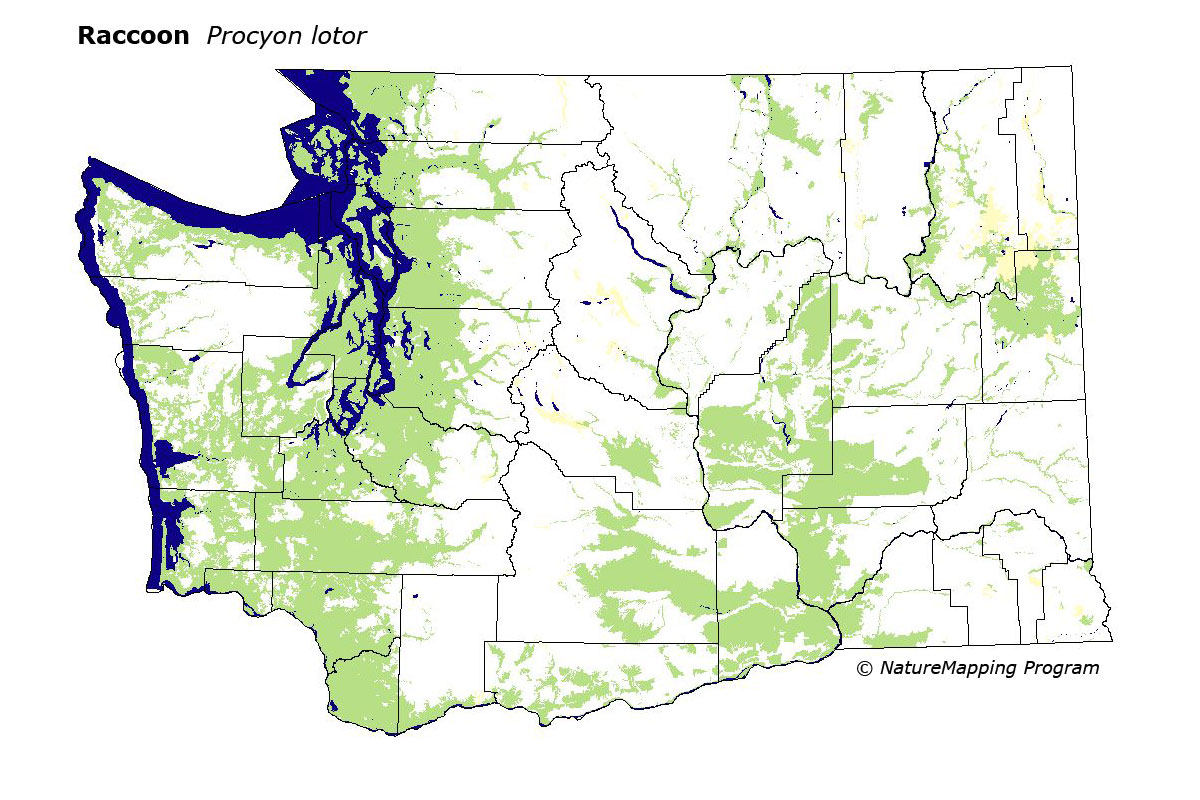
Food and Feeding Habitats
- Raccoons will eat almost anything, but are particularly fond of creatures found in water—clams, crayfish, frogs, fish, and snails.
- Raccoons also eat insects, slugs, dead animals, birds and bird eggs, as well as fruits, vegetables, nuts, and seeds. Around humans, raccoons often eat garbage and pet food.
- Although not great hunters, raccoons can catch young gophers, squirrels, mice, and rats.
- Except during the breeding season and for females with young, raccoons are solitary. Individuals will eat together if a large amount of food is available in an area.
Den Sites and Resting Sites
- Dens are used for shelter and raising young. They include abandoned burrows dug by other mammals, areas in or under large rock piles and brush piles, hollow logs, and holes in trees.
- Den sites also include wood duck nest-boxes, attics, crawl spaces, chimneys, and abandoned vehicles.
- In urban areas, raccoons normally use den sites as daytime rest sites. In wooded areas, they often rest in trees.
- Raccoons generally move to different den or daytime rest site every few days and do not follow a predictable pattern. Only a female with young or an animal “holed up” during a cold spell will use the same den for any length of time. Several raccoons may den together during winter storms.
Reproduction and Home Range
- Raccoons pair up only during the breeding season, and mating occurs as early as January to as late as June. The peak mating period is March to April.
- After a 65-day gestation period, two to three kits are born.
- The kits remain in the den until they are about seven weeks old, at which time they can walk, run, climb, and begin to occupy alternate dens.
- At eight to ten weeks of age, the young regularly accompany their mother outside the den and forage for them selves. By 12 weeks, the kits roam on their own for several nights before returning to their mother.
- The kits remain with their mother in her home range through winter, and in early spring seek out their own territories.
- The size of a raccoon’s home range as well as its nightly hunting area varies greatly depending on the habitat and food supply. Home range diameters of 1 mile are known to occur in urban areas.
Mortality and Longevity
- Raccoons die from encounters with vehicles, hunters, and trappers, and from disease, starvation, and predation.
- Young raccoons are the main victims of starvation, since they have very little fat reserves to draw from during food shortages in late winter and early spring.
- Raccoon predators include cougars, bobcats, coyotes, and domestic dogs. Large owls and eagles will prey on young raccoons.
- The average life span of a raccoon in the wild is 2 to 3 years; captive raccoons have lived 13.
A raccoon’s search for food may lead it to a vegetable garden, fish pond, garbage can, or chicken coop. Its search for a den site may lead it to an attic, chimney, or crawl space. The most effective way to prevent conflicts is to modify the habitat around your home so as not to attract raccoons. Recommendations on how to do this are given below:
Don’t feed raccoons.
Feeding raccoons may create undesirable situations for you, your children, neighbors, pets, and the raccoons themselves. Raccoons that are fed by people often lose their fear of humans and may become aggressive when not fed as expected. Artificial feeding also tends to concentrate raccoons in a small area; overcrowding can spread diseases and parasites. Finally, these hungry visitors might approach a neighbor who doesn’t share your appreciation of the animals. The neighbor might choose to remove these raccoons, or have them removed.Don’t give raccoons access to garbage.
Keep your garbage can lid on tight by securing it with rope, chain, bungee cords, or weights. Better yet, buy garbage cans with clamps or other mechanisms that hold lids on. To prevent tipping, secure side handles to metal or wooden stakes driven into the ground. Or keep your cans in tight-fitting bins, a shed, or a garage. Put garbage cans out for pickup in the morning, after raccoons have returned to their resting areas.Feed dogs and cats indoors and keep them in at night.
If you must feed your pets outside, do so in late morning or at midday, and pick up food, water bowls, leftovers, and spilled food well before dark every day.Keep pets indoors at night.
If cornered, raccoons may attack dogs and cats. Bite wounds from raccoons can result in fractures and disease transmission.Prevent raccoons from entering pet doors.
Keep indoor pet food and any other food away from a pet door. Lock the pet door at night. If it is necessary to have it remain open, put an electronically activated opener on your pet’s collar. Note: Floodlights or motion detector lights placed above the pet door to scare raccoons are not long-term solutions.Put food in secure compost containers and clean up barbecue areas.
Don’t put food of any kind in open compost piles; instead, use a securely covered compost structure or a commercially available raccoon-proof composter to prevent attracting raccoons and getting exposed to their droppings. A covered worm box is another alternative. If burying food scraps, cover them with at least 8 inches of soil and don’t leave any garbage above ground in the area—including the stinky shovel. Placing a wire mesh barrier that is held in place with a heavy object over the in-ground compost will prevent problems.
Raccoon Breeding Range
